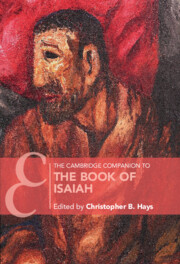Book contents
- The Cambridge Companion to the Book of Isaiah
- Frontispiece
- Cambridge Companions to Religion
- The Cambridge Companion to the Book of Isaiah
- Copyright page
- Contents
- Notes on Contributors
- Acknowledgments
- Timeline of Events Related to the Book of Isaiah
- Abbreviations
- Maps
- 1 Introduction
- Part I The Book of Isaiah Through History
- 2 The Book of Isaiah in the Neo-Assyrian Period
- 3 The Book of Isaiah and the Neo-Babylonian Period
- 4 The Book of Isaiah in the Persian Period
- 5 The Book of Isaiah at Qumran
- 6 Early Versions of Isaiah as Translations and Interpretations
- 7 The Formation of the Book of Isaiah
- Part II Isaiah in Its Cultural World
- Part III Isaiah as Literature
- Part IV Afterlives of the Book of Isaiah
- Scripture Index
- Other Texts Index
- Subject Index
- Cambridge Companions to Religion ()
- References
2 - The Book of Isaiah in the Neo-Assyrian Period
from Part I - The Book of Isaiah Through History
Published online by Cambridge University Press: 08 November 2024
- The Cambridge Companion to the Book of Isaiah
- Frontispiece
- Cambridge Companions to Religion
- The Cambridge Companion to the Book of Isaiah
- Copyright page
- Contents
- Notes on Contributors
- Acknowledgments
- Timeline of Events Related to the Book of Isaiah
- Abbreviations
- Maps
- 1 Introduction
- Part I The Book of Isaiah Through History
- 2 The Book of Isaiah in the Neo-Assyrian Period
- 3 The Book of Isaiah and the Neo-Babylonian Period
- 4 The Book of Isaiah in the Persian Period
- 5 The Book of Isaiah at Qumran
- 6 Early Versions of Isaiah as Translations and Interpretations
- 7 The Formation of the Book of Isaiah
- Part II Isaiah in Its Cultural World
- Part III Isaiah as Literature
- Part IV Afterlives of the Book of Isaiah
- Scripture Index
- Other Texts Index
- Subject Index
- Cambridge Companions to Religion ()
- References
Summary
In “The Book of Isaiah in the Neo-Assyrian Period,” Michael Chan offers an overview of the centuries of Assyrian dominance in the Levant. He takes five exegetical case studies that demonstrate the historical and literary impact of that Mesopotamian power on Isaiah and his successors in the eighth and seventh centuries bce. In particular, he observes how Assyrian imperial propaganda was subverted by the prophets in various ways.
- Type
- Chapter
- Information
- The Cambridge Companion to the Book of Isaiah , pp. 13 - 32Publisher: Cambridge University PressPrint publication year: 2024

